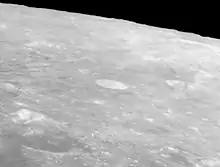Cayley (crater)
Cayley is a small lunar impact crater that is located in a lava-flooded region to the west of Mare Tranquillitatis. It was named after the 19th century British mathematician Arthur Cayley.[1] It lies to the northwest of the smaller crater De Morgan and the larger D'Arrest. West and slightly north of Cayley is Whewell, a crater of about the same dimensions. To the north is a linear rille designated Rima Ariadaeus, which follows a course to the east-southeast.
 Lunar Orbiter 4 image | |
| Coordinates | 4.0°N 15.1°E |
|---|---|
| Diameter | 14 km |
| Depth | 3.1 km |
| Colongitude | 345° at sunrise |
| Eponym | Arthur Cayley |
Description
This is a circular, bowl-shaped formation with a small interior floor at the midpoint. (Small being relative to the overall diameter, as it occupies about one-fourth the total cross-section.) The sloping interior walls are relatively light in hue, having a higher albedo as the surrounding terrain. However it is not nearly as bright as the slightly larger crater Dionysius to the east-southeast, and lacks a ray system.
The smooth, rolling plains to the east of this crater are called the Cayley Formation. It is somewhat similar to the lunar maria, but has a slightly higher albedo and is overlapped at the eastern edge by the Mare Tranquillitatis. Lunar scientists suspect that this plain may have resulted from deposits of ejecta from the formation of large impact basins such as Mare Imbrium or Mare Orientale. (The most likely source is the Mare Imbrium impact basin to the northwest.)
References
- "Cayley (crater)". Gazetteer of Planetary Nomenclature. USGS Astrogeology Research Program.
- Harland, D. M. (1999). Exploring the Moon: The Apollo Expeditions. Springer. ISBN 1-85233-099-6.
- Masursky, H.; Colton, G. W.; Farouk, E.-B. (1978). "Apollo Over the Moon: A View from Orbit (NASA SP-362)". NASA. Retrieved 2006-08-10. — see Fig. 46
- Wood, Charles A. (March 2006). "Looking Between Craters". Sky & Telescope.
- Andersson, L. E.; Whitaker, E. A. (1982). NASA Catalogue of Lunar Nomenclature. NASA RP-1097.CS1 maint: ref=harv (link)
- Bussey, B.; Spudis, P. (2004). The Clementine Atlas of the Moon. New York: Cambridge University Press. ISBN 978-0-521-81528-4.CS1 maint: ref=harv (link)
- Cocks, Elijah E.; Cocks, Josiah C. (1995). Who's Who on the Moon: A Biographical Dictionary of Lunar Nomenclature. Tudor Publishers. ISBN 978-0-936389-27-1.CS1 maint: ref=harv (link)
- McDowell, Jonathan (July 15, 2007). "Lunar Nomenclature". Jonathan's Space Report. Retrieved 2007-10-24.CS1 maint: ref=harv (link)
- Menzel, D. H.; Minnaert, M.; Levin, B.; Dollfus, A.; Bell, B. (1971). "Report on Lunar Nomenclature by the Working Group of Commission 17 of the IAU". Space Science Reviews. 12 (2): 136–186. Bibcode:1971SSRv...12..136M. doi:10.1007/BF00171763.
- Moore, Patrick (2001). On the Moon. Sterling Publishing Co. ISBN 978-0-304-35469-6.CS1 maint: ref=harv (link)
- Price, Fred W. (1988). The Moon Observer's Handbook. Cambridge University Press. ISBN 978-0-521-33500-3.CS1 maint: ref=harv (link)
- Rükl, Antonín (1990). Atlas of the Moon. Kalmbach Books. ISBN 978-0-913135-17-4.CS1 maint: ref=harv (link)
- Webb, Rev. T. W. (1962). Celestial Objects for Common Telescopes (6th revised ed.). Dover. ISBN 978-0-486-20917-3.CS1 maint: ref=harv (link)
- Whitaker, Ewen A. (1999). Mapping and Naming the Moon. Cambridge University Press. ISBN 978-0-521-62248-6.CS1 maint: ref=harv (link)
- Wlasuk, Peter T. (2000). Observing the Moon. Springer. ISBN 978-1-85233-193-1.CS1 maint: ref=harv (link)
External links
| Wikimedia Commons has media related to Cayley (crater). |
- Cayley at The Moon Wiki (now defunct)
- Wood, Chuck (December 12, 2006). "How Deep is That Hole". Lunar Photo of the Day. Archived from the original on June 14, 2011. - includes a couple of craters such as Cayley
- Wood, Chuck (2007-08-15). "A Formation of Surprise". Lunar Photo of the Day. Archived from the original on 2007-09-27. Retrieved 2007-07-15.

